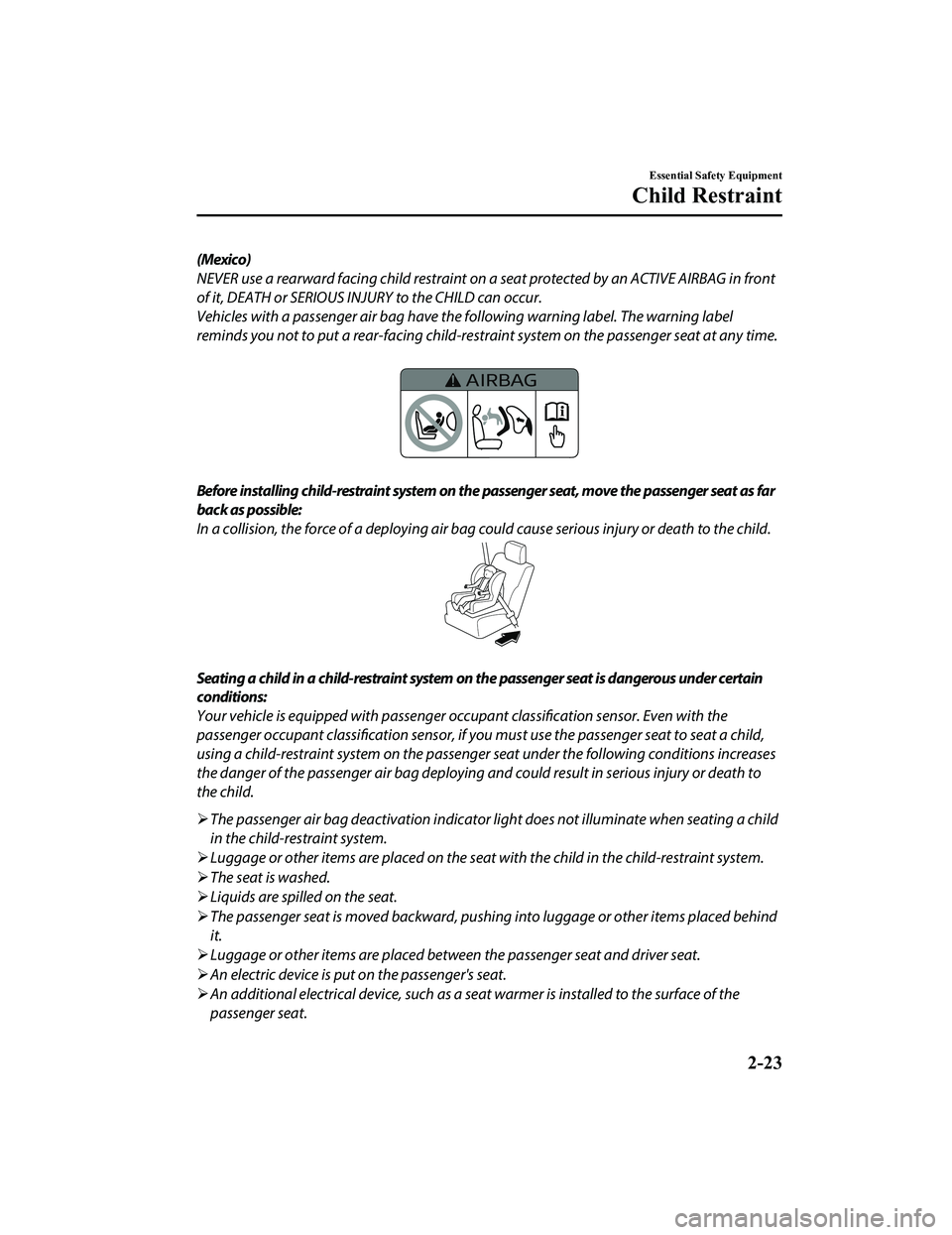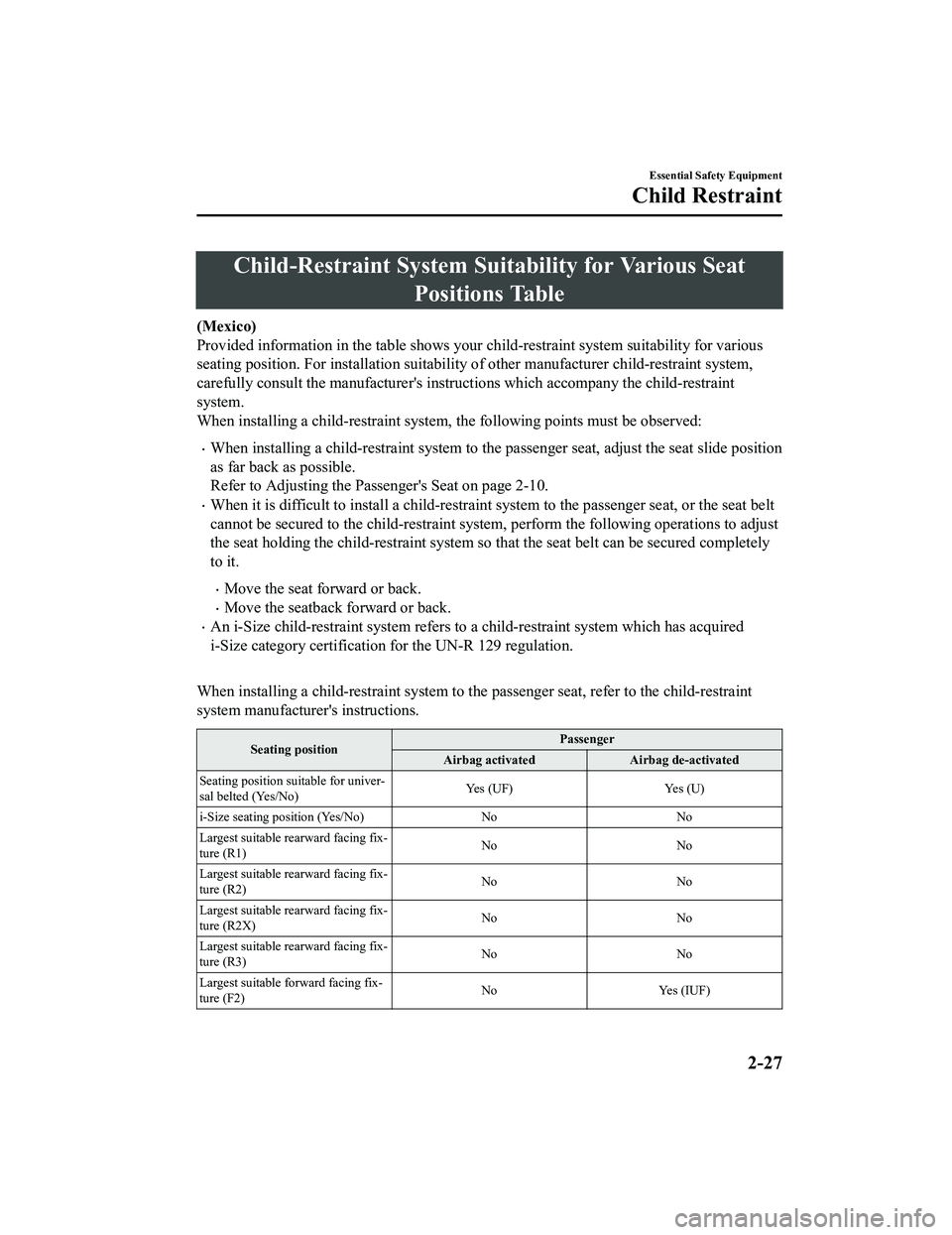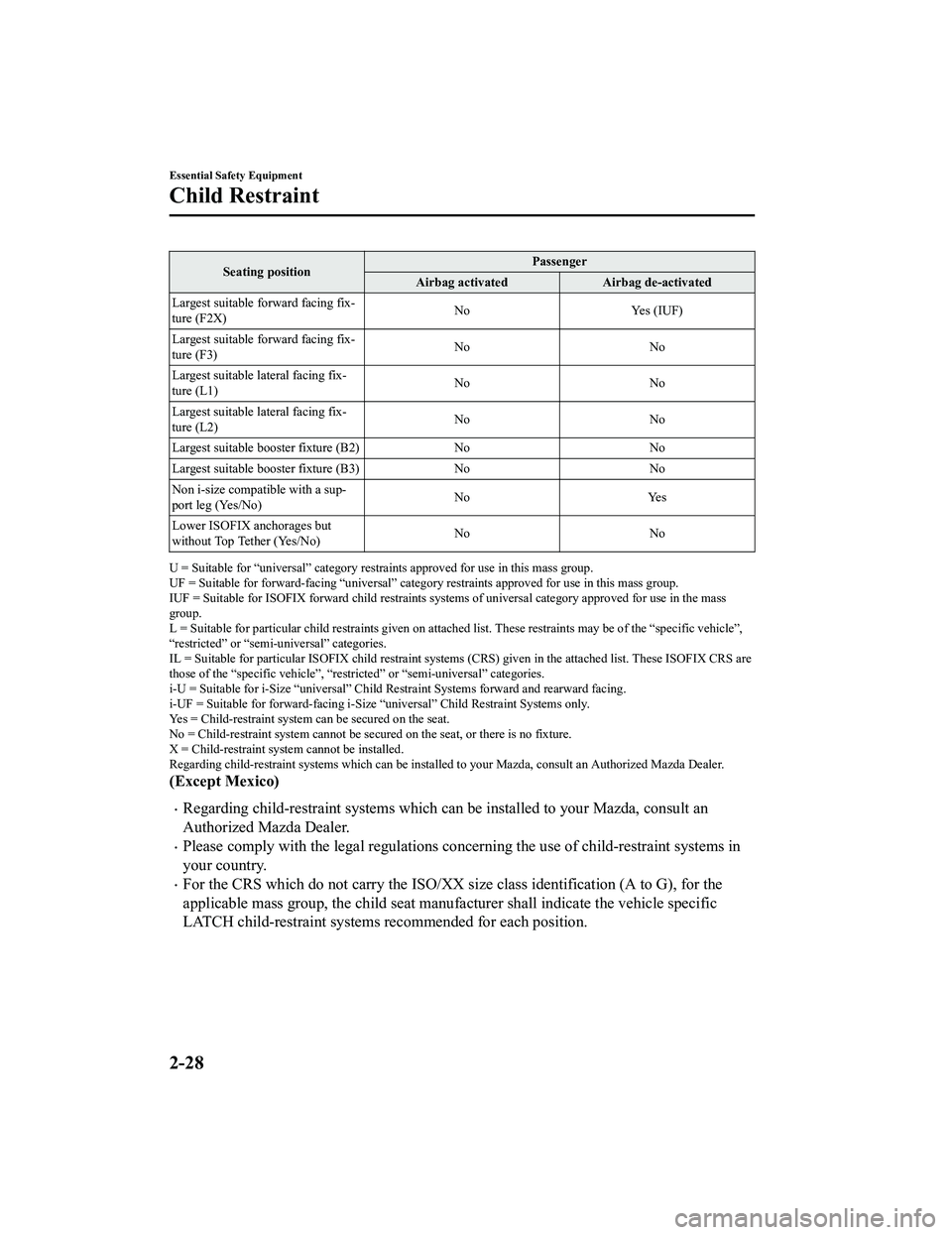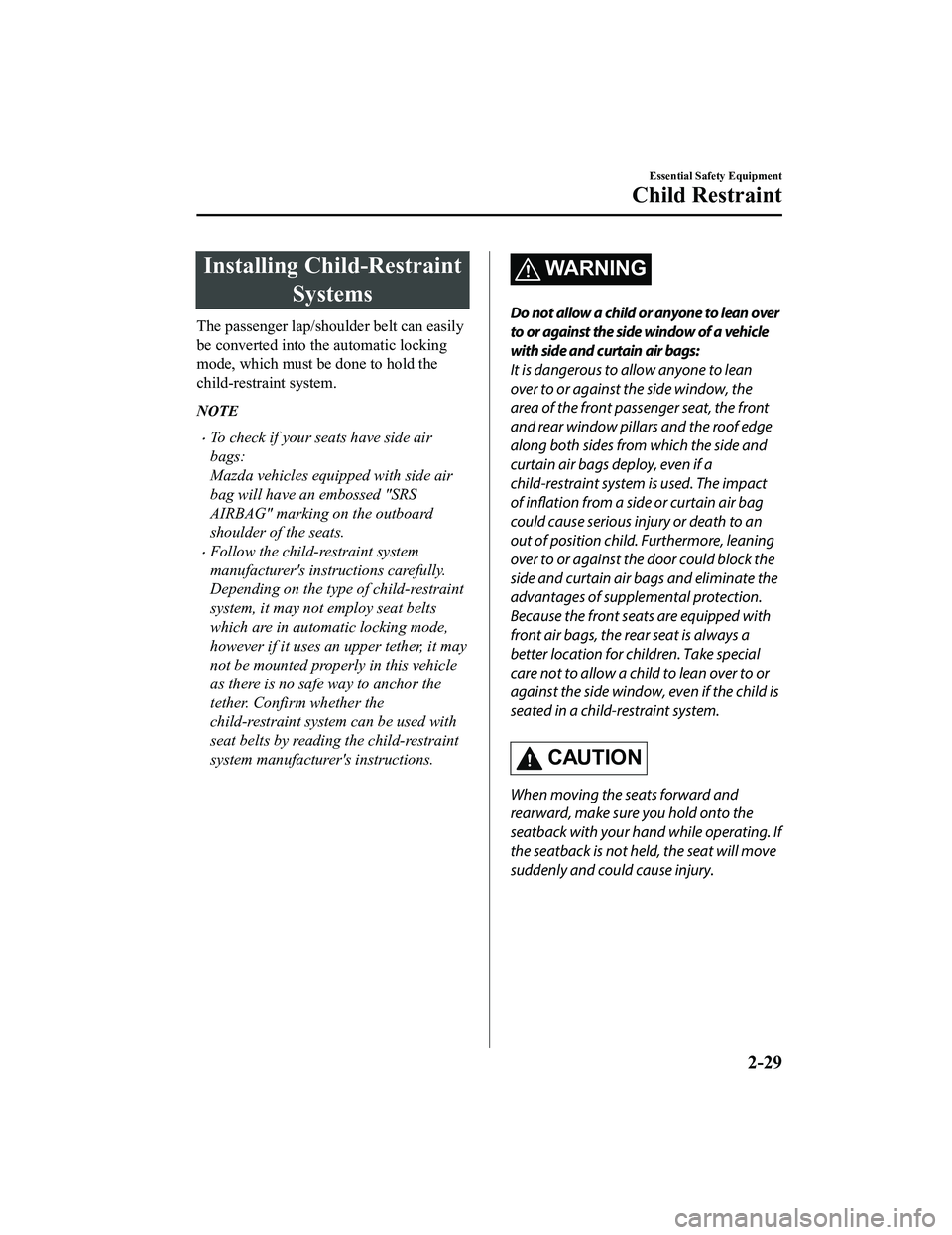airbag MAZDA MODEL MX-5 MIATA RF 2022 Owners Manual
[x] Cancel search | Manufacturer: MAZDA, Model Year: 2022, Model line: MODEL MX-5 MIATA RF, Model: MAZDA MODEL MX-5 MIATA RF 2022Pages: 503, PDF Size: 42.06 MB
Page 38 of 503

(Mexico)
NEVER use a rearward facing child restraint on a seat protected by an ACTIVE AIRBAG in front
of it, DEATH or SERIOUS INJURY to the CHILD can occur.
Vehicles with a passenger air bag have the following warning label. The warning label
reminds you not to put a rear-facing child-restrai nt system on the passenger seat at any time.
Before installing child-restraint system on the passenger seat, move the passenger seat as far
back as possible:
In a collision, the force of a deploying air bag could cause serious injury or death to the child.
Seating a child in a child-restraint system on the passenger seat is dangerous under certain
conditions:
Your vehicle is equipped with passenger occupant
classification sensor. Even with the
passenger occupant classification sensor, if you must use the passenger seat to seat a child,
using a child-restraint system on the passenger seat under the following conditions increases
the danger of the passenger air bag deploying and could result in serious injury or death to
the child.
The passenger air bag deactivation indicator ligh t does not illuminate when seating a child
in the child-restraint system.
Luggage or other items are placed on the seat with the child in the child-restraint system.
The seat is washed.
Liquids are spilled on the seat.
The passenger seat is moved backward, pushing into luggage or other items placed behind
it.
Luggage or other items are placed between the passenger seat and driver seat.
An electric device is put on the passenger's seat.
An additional electrical device, such as a seat warmer is installed to the surface of the
passenger seat.
Essential Safety Equipment
Child Restraint
2-23
MX-5_8KH8-EA-21K_Edition3_old 2021-11-10 13:10:56
Page 42 of 503

Child-Restraint System Suitability for Various SeatPositions Table
(Mexico)
Provided information in the table shows your child-restraint system suitability for various
seating position. For installati on suitability of other manufact urer child-restraint system,
carefully consult the manufacturer's instructions which accompany the child-restraint
system.
When installing a child-restraint system , the following points must be observed:
When installing a child-restraint system to the passenger seat, adjust the seat slide position
as far back as possible.
Refer to Adjusting the Passenger's Seat on page 2-10.
When it is difficult to install a child-restraint system to the passenger seat, or the seat belt
cannot be secured to the child-restraint system, perform the following operations to adjust
the seat holding the child-restraint system so that the seat belt can be secured completely
to it.
Move the seat forward or back.
Move the seatback forward or back.
An i-Size child-restraint syst em refers to a child-restraint system which has acquired
i-Size category certification for the UN-R 129 regulation.
When installing a child-restraint system to th e passenger seat, refer to the child-restraint
system manufacturer's instructions.
Seating position Passenger
Airbag activated Airbag de-activated
Seating position suitable for univer ‐
sal belted (Yes/No) Ye s ( U F )
Ye s ( U )
i-Size seating position (Yes/No) NoNo
Largest suitable rearward facing fix ‐
ture (R1) No
No
Largest suitable rearward facing fix ‐
ture (R2) No
No
Largest suitable rearward facing fix ‐
ture (R2X) No
No
Largest suitable rearward facing fix ‐
ture (R3) No
No
Largest suitable forward facing fix ‐
ture (F2) No
Yes (IUF)
Essential Safety Equipment
Child Restraint
2-27
MX-5_8KH8-EA-21K_Edition3_old 2021-11-10 13:10:56
Page 43 of 503

Seating positionPassenger
Airbag activated Airbag de-activated
Largest suitable forward facing fix ‐
ture (F2X) No
Yes (IUF)
Largest suitable forward facing fix ‐
ture (F3) No
No
Largest suitable lateral facing fix ‐
ture (L1) No
No
Largest suitable lateral facing fix ‐
ture (L2) No
No
Largest suitable booster fixture (B2) NoNo
Largest suitable booster fixture (B3) NoNo
Non i-size compatible with a sup‐
port leg (Yes/No) No
Yes
Lower ISOFIX anchorages but
without Top Tether (Yes/No) No
No
U = Suitable for “universal” category restraints approved for use in this mass group.
UF = Suitable for forward-facing “universal” catego ry restraints approved for use in this mass group.
IUF = Suitable for ISOFIX forward child restraints systems of universal category approved for use in the mass
group.
L = Suitable for particular child restraints given on attached list. These restraints may be of the “specific vehicle”,
“restricted” or “semi- universal” categories.
IL = Suitable for particular ISOFIX child restraint system s (CRS) given in the attached list. These ISOFIX CRS are
those of the “specific vehicle”, “restr icted” or “semi-universal” categories.
i-U = Suitable for i-Size “universal” Child Restraint Systems forward and rearward facing.
i-UF = Suitable for forward-facing i-Size “universal” Child Restraint Systems only.
Yes = Child-restraint system can be secured on the seat.
No = Child-restraint system cannot be secured on the seat, or there is no fixture.
X = Child-restraint system cannot be installed.
Regarding child-restraint systems which can be installed to your Mazda, consult an Authorized Mazda Dealer.
(Except Mexico)
Regarding child-restraint systems which can be installed to your Mazda, consult an
Authorized Mazda Dealer.
Please comply with the legal regulations concerning the use of child-restraint systems in
your country.
For the CRS which do not carry the ISO/XX size class identification (A to G), for the
applicable mass group, the child seat manufacturer shall indicate the vehicle specific
LATCH child-restraint systems recommended for each position.
Essential Safety Equipment
Child Restraint
2-28
MX-5_8KH8-EA-21K_Edition3_old 2021-11-10 13:10:56
Page 44 of 503

Installing Child-RestraintSystems
The passenger lap/shoulder belt can easily
be converted into th e automatic locking
mode, which must be done to hold the
child-restraint system.
NOTE
To check if your seats have side air
bags:
Mazda vehicles equipped with side air
bag will have an embossed "SRS
AIRBAG" marking on the outboard
shoulder of the seats.
Follow the child-restraint system
manufacturer's instructions carefully.
Depending on the type of child-restraint
system, it may not employ seat belts
which are in automatic locking mode,
however if it uses an upper tether, it may
not be mounted properly in this vehicle
as there is no safe way to anchor the
tether. Confirm whether the
child-restraint system can be used with
seat belts by reading the child-restraint
system manufacturer's instructions.
WA R N I N G
Do not allow a child or anyone to lean over
to or against the side window of a vehicle
with side and curtain air bags:
It is dangerous to allow anyone to lean
over to or against the side window, the
area of the front passenger seat, the front
and rear window pillars and the roof edge
along both sides from which the side and
curtain air bags deploy, even if a
child-restraint system is used. The impact
of inflation from a side or curtain air bag
could cause serious injury or death to an
out of position child. Furthermore, leaning
over to or against the door could block the
side and curtain air bags and eliminate the
advantages of supplemental protection.
Because the front seats are equipped with
front air bags, the rear seat is always a
better location for children. Take special
care not to allow a child to lean over to or
against the side window, even if the child is
seated in a child-restraint system.
CAUTION
When moving the seats forward and
rearward, make sure you hold onto the
seatback with your hand while operating. If
the seatback is not he ld, the seat will move
suddenly and could cause injury.
Essential Safety Equipment
Child Restraint
2-29
MX-5_8KH8-EA-21K_Edition3_old 2021-11-10 13:10:56
Page 51 of 503

Supplemental Restraint System (SRS) Precautions
The front and side supplemental restraint systems (SRS) include different types of air bags.
Please verify which kinds of air bags are equipped on your vehicle by locating the
“SRS AIRBAG” location indicators. These indicators are visible in the area where the air
bags are installed.
The air bags are installed in the following locations:
The steering wheel hub (driver air bag)
The passenger dashboard (passenger air bag)
The outboard sides of the seatbacks (side air bags)
The air bag supplemental restraint systems ar e designed to provide supplemental protection
in certain situations so seat belts are always important in the following ways:
Without seat belt usage, the air bags cannot provide adequate protection during an accident.
Seat belt usage is necessary to:
Keep the occupant from being thrown into an inflating air bag.
Reduce the possibility of injuri es during an accident that is not designed for air bag
inflation, such as roll-over or rear impact.
Reduce the possibility of injuries in frontal, near frontal or side collisions that are not
severe enough to activate the air bags.
Reduce the possibility of being thrown from your vehicle.
Reduce the possibility of injuries to lower body and legs during an accident because the
air bags provide no protection to these parts of the body.
Hold the driver in a position which allows better cont rol of the vehicle.
Refer to the Passenger Occupant Class ification System (page 2-49) for details.
The passenger air bag deactivation indicator light illuminates for a specified time after the
ignition is switched ON.
Ty p e A
Essential Safety Equipment
SRS Air Bags
2-36
MX-5_8KH8-EA-21K_Edition3_old 2021-11-10 13:10:56